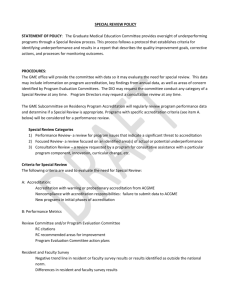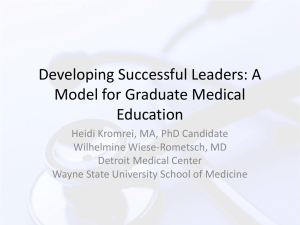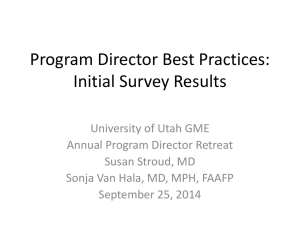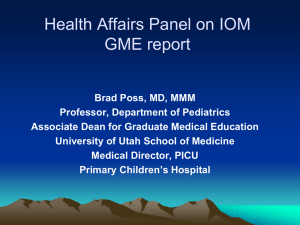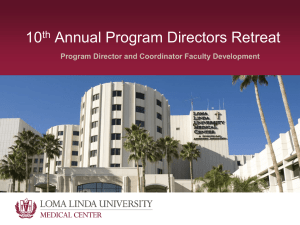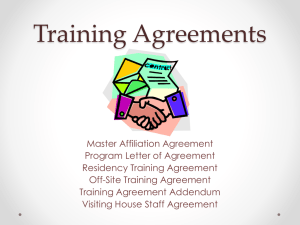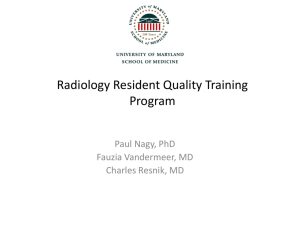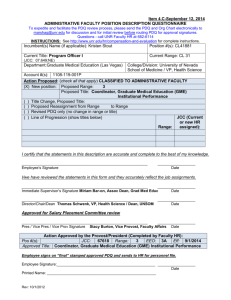Dr Alan Smith DIO - University of Utah
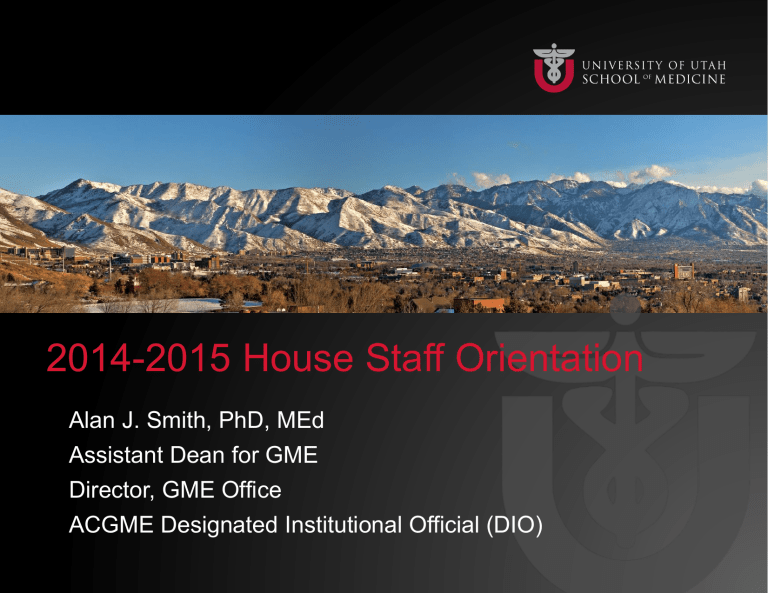
2014-2015 House Staff Orientation
Alan J. Smith, PhD, MEd
Assistant Dean for GME
Director, GME Office
ACGME Designated Institutional Official (DIO)
Sign-in/out Times T oday …
1.
7:30-8:00 AM: Registration & morning session
2.
Mandatory Sleep Deprivation session (1:00-1:30)
No one may leave during this session .
3.
3:00 PM: At completion of the day: turn in paperwork and pick up your ID badge.
Sign in/out sheets will be in the lobby/hallway outside this room. The Sleep Deprivation sheet will be passed around during the presentation.
2
Can You Start?
If You Are NOT CLEARED To
Start Working . . .
Breanna will call you out of this meeting
You cannot begin your program until your credentialing is complete
Breanna must clear you for hire
3
University of Utah GME
• 72 ACGME accredited programs
• 26 Residency programs with 558 residents
• 47 Fellowship programs with 157 fellows
• 34 GMEC approved (non-accredited) fellowship programs with 32 fellows
• 10 Dental Residents
• Total of 757 residents and fellows for 2014-2015
• 256 new residents and fellows for 2014-15
4
GME Growth
Match Numbers
70,0%
60,0%
60,0% 60,0%
55,4%
50,0%
44,6%
40,0% 40,0%
40,0%
30,0%
20,0%
10,0%
0,0%
2012 2013 2014
Male
Female
40,0%
30,0%
20,0%
10,0%
0,0%
100,0% 96,2% 95,5%
90,0%
80,0%
70,0%
60,0%
50,0%
3,0%
4,5%
93,0%
7,0%
2012 2013 2014
US Medical
School
Foreign
Medical
School
GME Organization
Senior VP for Health Sciences,
Dean, School of Medicine
Vivian Lee, MD, PhD, MBA
Chief Medical Officer
Thomas L. Miller MD
Assistant Dean & Director,
GME & DIO
Alan J. Smith, PhD, MEd
Administrative Manager
Chris Springman
Credentials
Coordinator
Breanna Stoll, MBA
Project Coordinat or
Melanie Powell
Staff Development Educator
Anne Vinsel, MFA
Information
Coordinator
Kyle Wheeler
Financial Manager
Sharee Bracken
Administrative
Coordinator
(E*Value)
Renn Butterfield
Accreditation
Coordinator
Ronnie Koon
GME Contact Information
Location
• School of Medicine Building, Level 1
Southeast Corner (1C412)
Webpage
• http://medicine.utah.edu/gme
• gme@hsc.utah.edu
Phone
• 801-581-2401
8
A few of the services provided by the GME Office
• Maintains your permanent training record
• Issues your annual contract
• Ensures that you receive your contracted salary and benefits
• Processes your loan deferments and forbearances
• Assists with your License Applications
• Issues your graduation certificate
• Provides Notary service
Resident Resources
• Resident representatives on Hospital,
School of Medicine, and Department committees
• Resident members of the GME
Committee
• Resident Interdisciplinary Council representatives
10
• You are expected to read your email regularly
• To access email electronically from off campus: www.umail.utah.edu
11
Policies and Procedures
• House staff Policies and Procedures
Manual available on GME website http://www.medicine.utah.edu/gme/
12
ACGME Requirements
13
Duty Hours
• The ACGME requires Sponsoring
Institutions to track duty hours across all accredited programs
• You will be required to enter your duty hours in the GME E*Value system.
(more about this later today)
Duty Hour Requirements
• Limited to 80 hours per week averaged over a 4-week period, including all approved moonlighting (PGY-1 residents may not moonlight).
• All trainees must have one day off in 7 over a 4-week period; at-home call may not be assigned on your free day.
Duty Hour Requirements
• Maximum duty period length:
PGY-1 must not exceed 16 hours in duration
PGY-2 and above may be scheduled a maximum of 24 hours of continuous duty plus
4 hours for transitions of care.
• Minimum time off between duty periods:
PGY-1 should have 10 hours, must have 8.
PGY-2 and above should have 10 hours, must have 8, but may be shortened in selected circumstances.
Levels of Supervision
• Direct Supervision
Supervising physician physically present with resident and patient (PGY-1)
• Indirect Supervision
Direct supervision immediately available – Supervising physician physically within site of patient care, and immediately available to provide direct supervision (PGY-1)
Direct supervision available
– Supervising physician not physically present within site of patient care but immediately available via phone, and available to provide Direct
Supervision (Intermediate level)
• Oversight
Supervising physician available to review procedures/encounters with feedback provided after care is delivered
17
Professionalism, Personal
Responsibility and Patient Safety
• Understand your personal responsibility to:
• Appear for duty appropriately rested and fit to provide the services required of your patients
• Actively participate in interdisciplinary clinical quality improvement and patient safety programs
• Assure the safety and welfare of patients entrusted to your care
• Manage your time before, during & after clinical assignments
• Recognize impairment, including illness and fatigue in yourself and your peers
• Honestly and accurately report duty hours, patient outcomes, and clinical experience data (e.g., logs)
• Comply with the Social Media Policy
18
Professionalism
• Professional Conduct Policy (GME 8.4)
• Social Media Policy (GME 9.7)
19
Transitions of Care
• Develop competence in communicating with team members in the hand-over process
• Inform all members of the health care team of current responsibilities for each patient’s care
Alertness Management and Fatigue
Mitigation
• Learn to recognize signs of fatigue and sleep deprivation
• Transfer care when unable to perform clinical duties
20
Teamwork
• Work as a member of effective interprofessional teams that are appropriate to the delivery of care in your specialty
ACGME Resident/Fellow
Survey
• Core specialty programs (regardless of size) and subspecialty programs (with 4 or more fellows) surveyed annually between January and June
• Survey data used in decisions affecting your program’s accreditation status
• ACGME sends link directly to resident
• Takes about 10-20 minutes to complete
Resident/Fellow Survey
Areas
•
•
•
• Duty hours (areas in which rules violated)
Faculty supervision and teaching
Evaluations (access to & opportunity to evaluate faculty and program; confidentiality)
Educational content (goals & objectives; fatigue management; scholarly activities; education/service balance)
Resident/Fellow Survey
Areas
•
•
•
•
Resources (access to reference materials; use of EMR)
Patient safety (pts informed of resident & faculty roles; culture reinforces pt safety; participate in QI activities; process to address concerns)
Teamwork (work in interprofessional teams)
Overall evaluation of program
Survey Report to Program
ACGME Next
Accreditation System
(NAS)
26
NAS
• In July 2013, the ACGME began a phased implementation of the Next
Accreditation System (NAS)
• All ACGME institutional and program accreditation will fall under NAS by July
2015
What is the NAS?
• Accreditation system based on continuous oversight rather than episodic sampling
• Program site visits at ~ 10 year intervals
• Emphasis on program effectiveness as evidenced by resident advancement through the Milestones
What is the NAS?
• Program status updated annually based on key performance indicators:
• Board certification exam results(rolling pass rates)
• Program attrition (residents, faculty, PD, chair)
• Resident survey results (annual)
• Faculty survey results (annual)
• Resident performance on Milestones
• Case logs (annual)
• Scholarly activity (resident and faculty)
Milestones
• Specific benchmarks of skills, knowledge, and behaviors that each resident is expected to achieve at identified stages of residency training.
• Milestones are associated with each of the six ACGME general competency areas:
• Medical Knowledge
• Patient Care
• Professionalism
• Communication and Interpersonal Skills
• Systems-based Practice
• Practice-based Learning and Improvement
Milestones
• Designed to allow tracking of discrete and measurable educational outcomes
• Progress of each resident to be assessed by program’s Clinical Competency Committee
(CCC)
• CCC members = Key Faculty + Program
Director
Milestones Exampl
e (Neurosurgery)
32
Level 1 Milestone?
“Whoa! Watch where that thing lands –
We’ll probably need it.”
